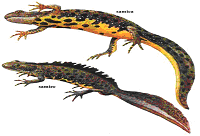THE GREAT CRESTED NEWT

The specific name is Triturus cristatus (cristatus derives from the Latin word meaning crested). (Also known as: Northern Crested Newt and the Warty Newt)
MTVCA are privileged to have Britain's largest and most threatened newt, the great crested newt, as a resident in the pond at number 5 Oaken Clough, which is now a site of biological importance. The species has a wide distribution in Britain, but is absent from Cornwall, Devon, and parts of Wales and Scotland and is generally uncommon. It is also widespread throughout northern and central Europe extending east to The Ural Mountains in Russia. The population has undergone a very severe decline in the last 50 years.
Appearance
As a species, it is generally dark brown to black in colour with a warty appearance. The underside is bright orange with black markings which are unique to each individual. Females tend to be slightly longer than males, and in the breeding season females develop an obvious crest between the head and the tail, and a silver streak along the middle of the tail. Outside the breeding season, males and females are fairly similar in appearance, but females always have an orange line on the tail. Juveniles generally look like females but may have a yellow stripe along the back.
Habitat
This species inhabits a wide range of habitats, including farmland, woods, grasslands, dunes, quarries, industrial and 'brown-field' sites within which it favours large ponds with abundant weeds and no fish. The habitat structure within the site such as hedgerows, and availability of refuges in which the individuals can hide is very important and can determine whether the species can occupy a site or not. The condition of land between occupied sites is also an important factor, as many newt populations persist as a series of local populations between which individuals migrate. If there is little connectivity between patches of suitable habitat, migration will be unlikely.
Biology
Great crested newts feed on a range of aquatic invertebrates, but occasionally tackle large prey items such as adult smooth newts and large dragonflies. They are mainly nocturnal spending the day at the bottom of ponds or hidden in vegetation. We recently happened across the newt during a careful dredging and tidying up of the pond at No.5.
Mating
Males have an extravagant display used in courtship which involves a male standing on his front legs in front of a female with an arched back while he waves his tail around. If the female is receptive the male transfers a spermatophore (a small packet of sperm) from his cloaca (reproductive and excretory opening) in the path of the female. He then moves sideways in front of her to gently encourage her into a position where the spermataphore will be pressed against and picked up by her cloaca - so "mating" is done without direct contact. The female lays two or three eggs a day between March and mid July, until 200 to 300 eggs have been laid. The eggs are laid on submerged aquatic plants, each carefully wrapped in a leaf for protection. (This makes our pond at No. 5 Oaken Clough very suitable as we have lots of leave coverage from water plants which edge the pond and, no fish). The larvae (or efts) hatch after about 3 weeks and then live in the pond as aquatic predators. After metamorphosis into air-breathing juveniles at about four months old, they live a terrestrial life until old enough to breed, which is at about two or three years of age. They may disperse at this age as far as 800 metres (about half a mile).
Both the juvenile newts and the adults (outside the breeding season) live in terrestrial habitats with dense cover, such as scrub, rough grass and woodland, usually within about 200 metres of the breeding pond. Again, this makes the woodland garden at No. 5 perfect as a habitat. They hunt small animals at night, such as insects, worms, woodlice, slugs and snails, and rest during the day beneath rocks, logs or other shelter. Their behaviour during their period on land is poorly understood.
During the winter months they hibernate under logs and stones or in the mud at the bottom of their breeding ponds. The newts normally return to the same breeding site each year, and can live as much as twenty-seven years, although up to about ten years is more usual.
Threats
The decline is due to a number of factors:
1. A large-scale loss of breeding ponds. Intensification of agriculture has resulted in many farm ponds becoming redundant and neglected and therefore numbers of suitable habitat have become diminished.
2. Many new ponds which would otherwise have been suitable for this species are now stocked with fish, which predate on both eggs and larvae. Even the ponds which survive in agricultural land often become polluted with pesticides and fertilisers.
Conservation
The great crested newt is a priority species under the UK Biodiversity Action Plan (BAP). The species action plan aims to maintain and enhance current populations. with a target of the restoration of populations to at least 100 sites. A number of publications on this species have been produced; English Nature has published 'Great crested newt mitigation guidelines' targeted at developers and others involved in land-use changes, which could cause conflict with conservation of this species.
Froglife has published 'The Great Crested Newt Conservation Handbook'.
(Ack. Wikipedia & BBC Science and Nature website)